|
Bristle/Fireworms (Errantiate Polychaete) Identification FAQs 10
Related FAQs:
Polychaete ID 1, Polychaete ID 2, Polychaete ID 3, Polychaete ID 4, Bristleworm ID 5, Bristleworm ID 6, Bristleworm ID 7,
Bristleworm ID 8,
Bristleworm ID 9,
Bristleworm ID 11, &
FAQs: Worm Diversity
FAQs,
FAQs 2,
FAQs 3, & Worm IDs
1, Worm IDs
2, Worm IDs 3, Worm IDs 4, Worm
IDs 5, Worm IDs 6, Worm IDs 7, Worm
IDs 8, & Worm ID FAQs by Group/Phylum: Flatworm Identification ID, Nemertean, Proboscis, Ribbon Worm ID,
Nematode, Roundworm ID,
Nematomorpha,
Horsehair Worm ID, Acanthocephalans,
Thorny-headed Worm ID, Tubeworm ID, Hirudineans, Leech ID, Sipunculids, Peanut Worm ID, Echiuran Worm ID, & Bristle/Fireworms 1, Bristle/Fireworms 2, Bristle/Fireworms 3, Bristle/Fireworms 4, Worm
Identification, Polychaete Behavior, Polychaete Compatibility, Polychaete System, Polychaete Selection, Polychaete Feeding, Polychaete Disease, Polychaete Reproduction,
Related Articles: Worms,
Polychaetes, Flatworms/Planaria ,
|
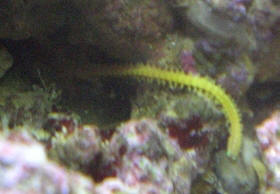
|
|
Weird Marine Worm? Black & White - NOT a Peanut Worm.
10/18/13
Hiya, I have been setting up my first marine tank, a TMC Aquahabitats 30
litre,
<Nice units>
over the past few weeks gradually adding live rubble and sand then live
rock and phytoplankton. Recently added more live rock plus one xenia and
one Ricordea. This morning I found this thing crawling out of a hole in the
new live rock, it's quite a cool little dude and I tried to find out what
it was and have ended up with either a bristle worm or a Eunicid worm.
Can you give a definite ID and let me know if it's good or bad?
Cheers.
P.S. I've seen about an inch or so so far but there may be more of it
inside the rock
<Ah yes; please read here:
http://wetwebmedia.com/echwrmidfaqs.htm
Bob Fenner>
|
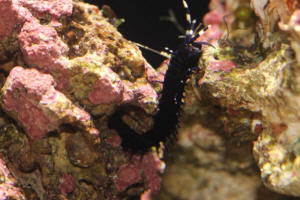 |
Re: Weird Marine Worm? Black & White - NOT a
Peanut Worm.
10/18/13
Hiya,
So what do you think it is as I doesn't look like an Echiuran of any form
:/ It's not squidgy looking like them and has 3-5 "antennae" in front of
it's head... It looks like a black and white Eunicid worm basically. It's
"antennae" are striped back and white but it's body is pure black with some
blue-ish tones included. It has little "spikes" on it's side that are
tipped with white. I don't know if you got the picture I included but I'll
include it again just in case along with a close up labeled version of it.
I can't get any more pictures as it won't come out properly now.
Cheers.
<Ahh, I do apologize. Yes; I "jumped to a conclusion" only looking askance
at the first image. This does indeed look to be a Eunicid (Errantiate
Polychaete) worm. There are some images of ones with the distinctive
black/white stripes on the antennae. Am out visiting, giving talks in CT,
and my laptop screen is small, and my vision... more bunk than I wish. Bob
Fenner> |
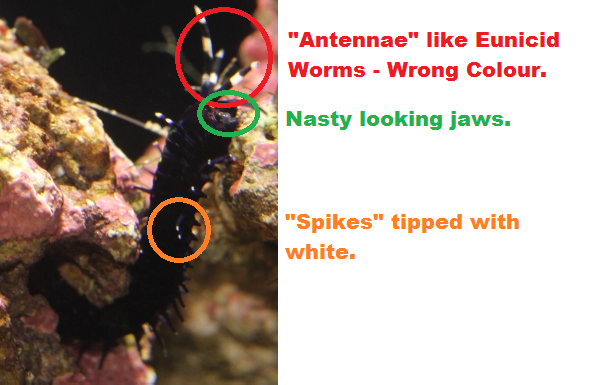 |
Re: Weird Marine Worm? Black & White - NOT a Peanut Worm. 10/19/13
Hiya,
That's bad news for my tank then :(
Thank-you.
<Easy enough to bait, trap out. BobF>
Re: Weird Marine Worm? Black & White - NOT a Peanut Worm.
10/21/13
Hiya,
I got him out.
<Ah ha!>
He's approximately 6-8 inches long altogether!
I'm giving him to my local as they have a tank they want to put him in
because he's black and white.
Thanks for your help.
<Thank you for sharing. BobF>
|
Re: Do epitokes have jaws? 3/14/13
Bob
I am steadily working through your WebPages - extremely useful but not
enough time in the day....
Many thanks for your help
Kirsteen
<Mmm, thank you in turn. There is a "search w/in the page you're
searching" tool at top, right, that Darrel instigated/installed on every
page. BobF>
|
Howsit? Yes, on Xmas, am going over pix...
12/25/12
Lynn... do you have any idea what this might be? Looks so much like a
trap door spider opening... underwater! In Cozumel this last week. B
<Wow, I know I've seen one of these before, but can't remember what made
it. I'll get back to you as soon as I figure it out. Take
care, Lynn>
Oh, thank you... have a couple more pix of this/it... but all about the
same. Cheers! B
|
.JPG) |
Re: Howsit? Yes, on Xmas, am going over pix...
12/26/12
Hi Bob,
I think the webbing is part of a eunicid's lair. When I see
webs, the first thing I think of is a vermetid but in this case, the entire
structure, combined with the associated threads, looks too intentionally
shaped and anchored - like that of a funnel-web/trapdoor spider. A
vermetid’s would have been a lot messier and more random.
I’ve heard about these webs, specifically from Eunicids, but have never seen
one in person. It’s entirely possible that other Polychaetes
build/live in such, but I just don’t know of them. I looked through
all my resources, and on the web, but with no luck. I did, however,
manage to find a couple of photos showing Eunicid webbing, but one is small
and hard to see detail and the other is detailed but shows a much smaller
web example (in the sand, not anchored to nearby rocks).
Small photo, 2nd one down, showing webbing across the back of the tank:
http://www.dailykos.com/story/2008/12/11/672001/-Marine-Life-Series-A-Worm-Named-Eunice
<Ah, I read the description as "a spider web" there>
Webbed lining w/some around perimeter:
http://www.scuba-equipment-usa.com/marine/MAY04/Sand_Worm(Eunice_sp)4.html
<Ah yes; we have a winner!>
Wish I could give you a concrete answer but unfortunately, a somewhat
educated guess is all I can offer!
Take care,
-Lynn
<Thank you for yet another mysterious pic/organism solved. BobF>
Re: Howsit? Yes, on Xmas, am going over pix...
12/26/12
You're very welcome, Bob - it was a pleasure as always!
-Lynn |
|
Powder Blue Tang, parasitic worm? 9/28/12
Good evening, I purchased a Powder Blue Tang, a Desjardinii Tang and two
Fairy Wrasse's through Liveaquaria.com a little over two weeks ago. They
all went into a 29 gallon bare bottom quarantine tank with a few pieces
of live rock out of my sump to help with water quality. I did twice
daily water changes to maintain the water quality for the first 10 days
when it finally leveled out. All of the fish are doing great, eating
frozen Mysis in the morning followed with seaweed blend on a lettuce
clip. Even the wrasses seem to enjoy eating the seaweed which surprised
me. Anyways, all fish looked quite healthy when they arrived. I did not
do a freshwater dip as I now see you recommend. The third day I saw what
appeared to be a thread hanging on the eye of the Powder Blue Tang. I
watched it closely for another day and it appeared to stay the same.
Assuming it was a parasite I dosed the tank with PraziPro per
instructions. Within 3 hours the
"thread" had detached and was on the bottom of the tank. I used a
transfer pipette to suck it up and placed it under a microscope, please
see attached photo.
<I see this/it>
I'm assuming some sort of a fluke.
<Mmm, a worm of some sort... but too spiny to be a Trematode in my
experience>
I have not seen another one on any of the fish, nor have I seen any
other signs of disease. I'm keeping the tank at 80 degrees and specific
gravity of 1.020. My question is, I was doing such large water changes
twice daily to keep the water quality up so I would replace the PraziPro
with the appropriate amount but I only did this for four days. The
instructions say to dose with a single treatment lasting for 5-7 days.
Do I need to do another treatment or should I just continue to watch.
<I'd do the latter>
I plan on leaving them in quarantine for at least 4 to 5 weeks total as
I know the Powder Blue's are known as Ich magnets. Honestly, now that
I've got them I'm completely paranoid that I will introduce crypto to my
main tank, it's a 180 gallon reef and I've been down that road before
several years ago. I left it fallow for 6 weeks and haven't had a
problem since.
Would I be better off with a little longer quarantine?
<A trade off at about six weeks... little benefit vs. stress past that
period of time>
I've read that the powder blues don't always do well so that is somewhat
of a concern, however, this is one of the healthiest groups of fish that
I've purchased in several years. Thanks for your time.
Julie
<Am going to "shop around" your pic... See what others think. To me this
looks like a juvenile Errantiate Polychaete... Bob Fenner>
|
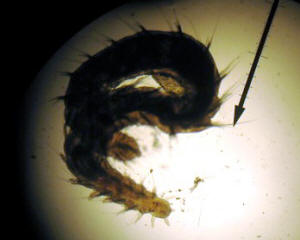 |
9/28/12
<Sabrina looked and she concurs that this appears to be a
small Bristleworm... I think it/this "just happened" to be on the Tang...
that it originated from the bit of live rock you'd placed in the tank. Not
parasitic. BobF> |
Blue worm, "You put the moon in
my eyes..." he might eat them? oh no! 3/9/10
OK, so should I ask my fish tank person (I live in Ann Arbor during
the week and on Lake Michigan on the weekends, that is where my
fish are) to try to get rid of him?
<Mmm, up to you... not likely to change its behavior
overnight... Whatever food/circumstances have precluded it munching
on your macro-stock to date...>
Will he know how to do that given how big he is.
<... please read where you were initially referred to. There are
FAQs files on control...>
He might be 14 years old as the rock has been there that long. He
only ate the dead fish so far. Matt, my caretaker during the week
said he was okay, but now I don't know. He got my first fish
for me and all 4 of them died, however, he designed the tank 14
years ago and has been taking care of it and the sub-tank in the
basement since then.
<Neat!>
All the fish that came with the tank are alive except my clown fish
(I loved the little guy) Do I trust him (Matt)?
<Obviously so>
I get so attached to those little guys, I just can see them die!!!
Two of my tangs are huge (several years old) and beautiful and so
are my starfish (the worm spent two days laying right next to the
starfish and didn't eat him). If he hasn't eaten them so
far should I assume I am safe and that he will just eat the
occasional crab or snail?
<Likely so>
Have you ever seen one with a bright blue stripe like in the pic I
sent?
<Yes... see my bio., posted on WWM, in books I've penned...
I've spent a few years "sorting and identifying"
Errantiates>
Where can I go to read about these blue stripped worms.
<Again...>
I am an attorney and therefore a reader by trade.
<Maybe have your assistant, paralegal read for you?>
I like to do things right and simply can't see my investment go
down the tank. The aquarium is part of a wall in my library in my
beach home and is so beautiful framed in imported cherry.
<Nice!>
It is so beautiful and I have ordered several hundred dollars worth
of fish and other things. I ordered two feather dusters that he
will get for me (he goes to Lansing, Michigan and gets the fish
himself). What if he eats them!!!!
<... so?>
These guys are my little friends and I simply can't take
"he might eat them." Please tell me where to read about
these blue and red stripped worms. Help me! My little weekend
friends are in danger.
Thank you ever so much for you kind attention to my requests. I am
new to this and I really love it.
Marti Liska
<Thank you for sharing Marti. BobF> |
Green Caterpillar-Looking Worm
-- 2/23/10
Hi there,
<Hello there, Lynn here today.>
I am a beginner aquarist and have a small saltwater tank.
<Yay, welcome to the hobby!>
I have sighted a green caterpillar-looking worm on my live rock.
<Neat>
I have spent hours looking for a similar worm (if that's what it
is).
<It works (for me anyway) as a broad term for any soft bodied,
elongate critter with a head at one end, that either has no legs at
all, or many on either side (like a centipede or caterpillar). In
saltwater, there are many, many worm-like organisms -- from the
bizarrely shaped to the seemingly very simple.>
I've only seen it twice, but since I am such a novice, I need to
know if it is harmful or just let it be.
<I'd leave it. Most of these small hitchhiking 'worms'
are beneficial or at least fairly innocuous in reef systems.>
My water tests have been close to perfect for 2 months.
<Sounds good. Just remember to be specific with these numbers (as
well as tank size and current livestock) if/when you need to write us
with any questions related to water quality, disease, and so forth. For
an ID query like this, we're good to go!>
Have you ever seen something like this?
<Well, I've seen bright green worms before, but without a photo,
I'm not sure if they looked like yours! If the individual you have
is long and skinny, with many bristly legs, it could easily be a
Phyllodocid (a common Polychaete in the family: Phyllodocidae). If
there are no apparent legs, it could be a Nemertean (Phylum: Nemertea).
Both prey mostly on small invertebrates but should have negligible
impact on a healthy population. Beyond the two possibilities already
mentioned are a host of others. Again, I'd leave this little fellow
in place and enjoy. For more information regarding Phyllodocids,
Nemerteans, and other worm-like critters, please see the following
links:
http://www.chucksaddiction.com/hitchworms.html
Be sure to check out the related/highlighted links at the top of the
following pages as well:
http://www.wetwebmedia.com/worms.htm
http://www.wetwebmedia.com/polychaetes.htm
It is approximately 1 1-1/4 inches.
<Gotcha, thanks>
Thank you very much for your help!
<You're very welcome and thank you writing us. I hope that your
first experience here has been a positive one for you. Take care,
LynnZ>
Re: Green Caterpillar-Looking Worm -- 2/23/10
Dear Lynn,
<Hey Victoria and Kyle!>
I really appreciate your speedy response.
<It's a pleasure. I know all too well what it's like to find
something odd in a tank and wonder what it is!>
I will try to take a photo of the critter the next time he is out in
the open.
<Excellent>
He does not have any legs and looks EXACTLY like a green caterpillar
with little thorn looking things all over.
<Hmmm, thorny sounds more like a Sea Cucumber, but it could also be
some sort of Nudibranch or Sea Slug. Please see the following links for
comparison:
Sea Cucumbers: http://www.wetwebmedia.com/seacukes.htm
Nudibranchs - 6 pages, starting here:
http://www.wetwebmedia.com/nudibran.htm
Sea Slugs: http://www.wetwebmedia.com/seaslugsopisthobranchs.htm
>
I will hope that he is a helpful janitor and not a menace.
<Me too. We'll know more once we figure out what it is. By the
way, if you've added any corals at all, let me know what variety.
Also, if you know where this animal hitchhiked in from, that would be
terrific.>
I have had 2 peculiar snail deaths (orange shelled guys).
<I'm not sure what variety this is. Do you have any other
snails? If so, how are they doing?>
I will definitely be coming to your website a lot in the future!
<Great!>
Very well done and informative!
<On behalf of Bob and the crew, thank you very much!>
Thank you VERY much!
<You're most welcome!>
Victoria and my 8 year old son, Kyle
<Y'all take care, LynnZ>
|
Worm ID Needed 02/02/10
Last night I was walking by my tank, saltwater. I noticed this
tiny orange colored worm on the glass. I have attached a photo
showing it. The worm is only about 1/2" long. It was on the
glass long enough to get a photo,
and then it kind of curled up and floated back to the substrate.
Any ideas?
<The photo is not clear... but, from what you describe, this
looks/sounds like an epitoke (a swimming reproductive stage) of
an Eurythoe sp. bristle worm.
Here's a nice site for worm IDs
http://www.chucksaddiction.com/hitchworms.html>
Cary Meredith
<Cheers,
Sara M.>
|
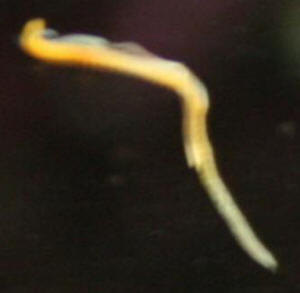 That babe is on! RMF That babe is on! RMF |
|
Help with Worm ID: Likely Terebellid --
1/26/10
Hello Crew,
<Hello Ariel, Lynn here today.>
I've been a big fan of your website for many years. This is
actually my first question since I usually find the answers
here.
<Let's get to it then!>
I have a small ten gallon that I use for quarantine. It has some
live rock and sand. I'm recently using it since I bought some
corals but I had the lights off for about a month or more since I
had broken the bulb. I noticed two days ago that I have a certain
tube worm creature under one of the rocks and would like to know
if it's bad.
<Probably not. The overwhelming majority of worm/worm-like
hitchhikers we see are actually harmless/beneficial. The rest are
mostly innocuous with only the occasional troublemaker.>
The tube is about an inch high kind of built out of sand grains
it looks like. Then it has some tentacles sticking out of the
top. Maybe 5 or 6 of them. They kind of search around the rocks
like looking for prey.
<Bits of detritus.>
They get pretty long. One in particular was about 6 to 8 inches
long reaching around the next rock. Thinking maybe like a
Terebellid worm or Spionid worm?
<I think you hit the nail on the head! It sounds like a
Terebellid (aka spaghetti worm). They're harmless,
tube-dwelling, detritivores that extend numerous thin tentacles
over surfaces in search of food particles. Spionids are neat
little Polychaetes as well, but have two small feeding
palps/tentacles instead of many.>
Thanks in advance
<You're very welcome.>
Ariel
<Take care, LynnZ>
|
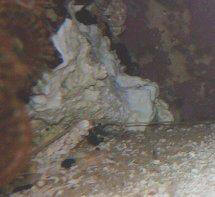 |
|
Question about my Salt water aquarium
Predatory worm? -- 01/12/10
There is this creature living in my 72gal salt water tank,
I'm pretty sure it is the reason I lost my red star, and my
sand-sifting star. I saw it one day, pulling my red star into a
burrow under a rock! It's pretty long as I see from under my
tank, (about 6+ inches)...
<Looks like a potentially large Polychaete worm of the family
Eunicidae... mostly IDd as Eunice sp. or Palolo sp. in the hobby.
Generally rather scavengers than predators (maybe the sea stars
were not so perfectly healthy), but can eat sessile or even weak
mobile life forms if no other food is available.>
Any advice?
<Should be separated from the other stock. Can be an
interesting animal to study in a setup on its own.>
Thanks! Joshua.
<Welcome. Marco.>
|
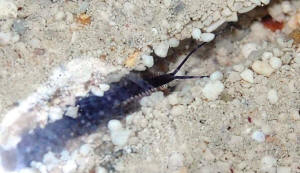 |
Red Stringy Creature: Likely
Cirratulid -- 10/14/09
Hello,
<Hello Lori, Lynn here this morning.>
Since I put up my salt water tank (6 months ago), right next to the
glass burrowing down through the substrate, is a thin red line. I have
noticed that it has like a tangled mass of red with several 3"
thread like tentacles coming from the sand and flowing with the
current. Yesterday it relocated itself. But it doesn't seem to be
bothering anything. What is it?
<Sounds like a Cirratulid (family Cirratulidae) commonly known as a
'hair worm'. These Polychaetes are beneficial/harmless,
detritus/organic particulate matter feeders, typically orange, red,
brown, or black in color, <2' in length, segmented, narrow,
substrate dwellers, with filaments (gills/"branchiae")
arranged along the length of the body. For more information/photos,
please see the many WWM FAQ's regarding, as well as the following
article:
http://www.reefkeeping.com/issues/2002-06/rs/index.php
Enter the term Cirratulid in our Google search engine:
http://www.wetwebmedia.com/Googlesearch.htm
Here's something to get you started (see second FAQ listed:
http://www.wetwebmedia.com/polychaeidfaq2.htm
Lori A. Pickett
<Take care, LynnZ>
Red Stringy Creature: Likely Cirratulid -- 10/14/09
Thank you for your help :)
<It was a pleasure, Lori. Take care, LynnZ>
|
Worm: Cirratulid -- 10/3/09
Hi all!!!
<Greetings Mars, Earthling Lynn here today!>
Was cleaning my 120g reef when I saw this floating in the
current.
<It's a neat Polychaete!>
The worm is about 1.5cm in length and very skinny, bright red. It
looks like one main worm with little ones growing out of it.
<Yep>
Almost like a tree trunk with branches coming out of the trunk.
Most of the branching comes out of one end but there is branching
from different parts of the main trunk/worm. It looks like giving
worm birth but from different areas of the worm. Any guesses as
to what it is or is going on?
<It looks like a Cirratulid (family Cirratulidae), commonly
known as a 'hair worm'. These Polychaetes are
beneficial/harmless, detritus/organic particulate matter feeders,
typically orange, red, brown, or black in color, <2' in
length, segmented, narrow, substrate dwellers, with filaments
(gills/"branchiae") arranged along the length of the
body. Whew! They're often confused with Terebellids (aka
'spaghetti' worms) but the most obvious difference is the
Terebellid's lack of filaments along the body. They have a
cluster of feeding tentacles at the head area, but that's it.
The worm you have may well have had more branchiae present before
you found it. Apparently, they detach fairly easily. Cirratulids
are preyed upon by the usual suspects: various crabs, shrimps,
fishes, hermits and the like so the one you have may have been
nibbled on a bit. For more information on these neat little
worms, please see the following link:
http://www.reefkeeping.com/issues/2002-06/rs/index.php >
Pics were taken 40x magnification.
<Nice, thanks!>
Thanks a bunch!
<You're very welcome. It was a pleasure.>
Mars
<I love that name! Take care, LynnZ>
|
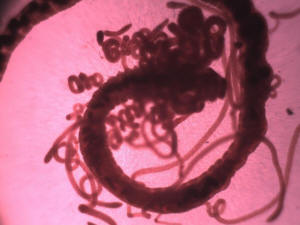
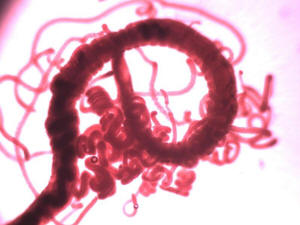 |
|
What Kind of Polychaete Worm 9/21/09
It has many soft appendages of equal length the run the entire
length of its body.
Found a link with a part of a picture
(http://www.sanctuarysimon.org/farallones/sections/invertebrates/overview.php)
Is it ok in my Nano cube or should I leave it out?
<I'd leave it>
I also caught a worm that was swimming as well as a fish last
night. It was almost an inch long and resembled Eunice
antennata.
<Neat!>
Thank you,
Kirk
<And you. See here:
http://wetwebmedia.com/polychaeidfaqs.htm
and the linked files in the series above. Bob Fenner>
|
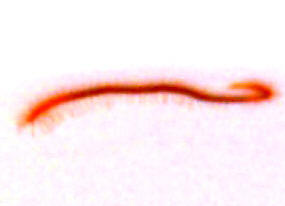
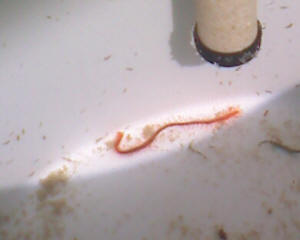 |
Re: What Kind of Polychaete Worm
9/21/09
<I'd leave it> ?? out of my cube since I have it in a
collection cup now or put it into my Nano cube?
Do you know what kind it is?
Thank you,.
Kirk
<Mmm, could only guess to family level... Please peruse the ID
files where you were referred to. B> |
|
Please help with ID of this worm: Likely Terebellid --
7/19/09
<Hello Chris, Lynn here this evening.>
I picked up a batch of Fla. cultured live rock yesterday and
found a worm lying at the bottom of the tub.
<Neat>
It's around 3' long and the thickness of a pencil.
Attached is a partial picture showing a somewhat flat body, with
one very slight row of hairs/bristles running down each side. By
this morning it had partially wedged itself into a crevice on one
rock, but the tail end is still exposed. One end (presumably the
tail) tapers down to a point. The other end has a round opening
like a feather duster. When I first found it, there were dark
brown string like threads (around 3/4' long) coming out of
the opening...I'd describe it as looking a little like a mop
head. Not at all like the feathery tips of a feather duster - and
it didn't retract when disturbed, like a feather duster
would. Unfortunately, I didn't get to take the photo when the
threads were exposed. They're now totally retracted and
haven't come out all day. The body contorts when agitated,
and isn't at all hard like a feather duster's. I looked
online (and in Humann's critter ID book) and I can't find
anything like it. Any ideas?
<It sounds like a Polychaete worm in the suborder Terebellida,
of which there are many families, genera, and species. The ones
most hobbyists are familiar with are those in the family
Terebellidae, commonly known as spaghetti worms. It's
possible that this is what you have. They typically live in
burrows or crevices; have a roughly conical body shape, and a
multitude of tentacles radiating from the head. Normally, all you
see of these creatures are the tentacles spread out over the
rock/substrate surface where they gather food. At any rate, this
group of worms is comprised of mostly harmless deposit feeders so
no worries about them attacking livestock. Sometimes their
tentacles can irritate corals however - not because they sting
but because the particular coral doesn't appreciate the
contact. On the whole, they're a welcome addition to a
cleaning crew. Please see the following links for more
information:
http://www.reefkeeping.com/issues/2002-06/rs/index.php
Google Terebellid at WWM for FAQ's re:
http://www.wetwebmedia.com/Googlesearch.htm >
If the picture is not clear enough, I suppose I could pull it out
of the crevice for a better shot.
<Nah, I'd leave the little guy where he is. He's had a
rough couple of days!>
Thanks,
<You're very welcome.>
Chris
<Take care, LynnZ>
|
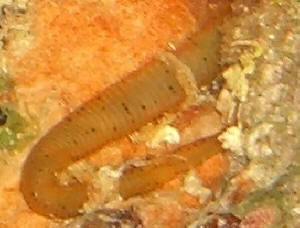 |
|
Red Tentacle Worm: Possible Cirratulid or Terebellid
-- 4/29/09
Hey,
<Hello, Ryan>
I have not found any information that specifically related to
this worm. It is segmented, with LOTS of tentacles coming
off.
<Up and down the length of the body, or concentrated at the
top/head area?>
Initially I assumed it was a spaghetti worm, but it is solid
white. Currently, at the head end, it is about 339um in width. I
am very curious to find out what this is, especially since it is
in a tank with some corals, and a pipefish.
<It looks like either a Terebellid/spaghetti worm (numerous
long, very thin tentacles emerging from the head area only) or a
Cirratulid/hair/medusa worm (2 feeding palps, shorter tentacles
emerging along the length of the body). Both are beneficial,
deposit feeding Polychaetes that are generally harmless except in
situations where the population has become excessive. In these
cases, it's possible that too much contact with the tentacles
could irritate the coral. When/if this happens, the offending
Polychaete can either be removed manually if it's located
within the soft sediment, or sealed into its home in the rockwork
using frag/'super' glue. Thankfully, this sort of problem
doesn't happen all that often, so you should be okay. For
more information, please see the following links:
http://www.wetwebmedia.com/polychaeidfaqs.htm
http://www.reefkeeping.com/issues/2002-06/rs/index.php
More info at WWM regarding these -- just enter the terms in our
search engine:
http://www.wetwebmedia.com/WWMAdminSubWebIndex/question_page.htm
>
Thanks, Ryan.
<You're very welcome. Take care, LynnZ
I have taken many pics under a microscope, these were the top
three for showing its shape, and tentacles.
<Thanks, great photos!>
|
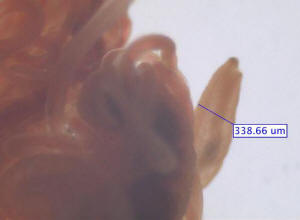 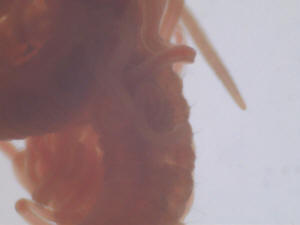 |
Yellow Worm ID: Errant
Polychaete -- 4/2/09
Crew,
<Hello, Josh>
I saw this worm like creature in my 150 gallon that I'm still
building this morning when the lights kicked on. I had just added a
second load of live rock the night before. There are still no fish and
the tank has just finished a Cycle. He's about 4-5 inches long. His
head has a different section that is a very bright yellow, and then his
body is a duller yellow. He didn't appear to have bristles or legs,
but I could have missed them. I also did not get a good look at its
mouth. It is not flat. That's about all I can tell you. I
couldn't find anything like this in my own searches, and was hoping
someone here might be able to help out.
<Unfortunately, I can't see enough detail to be more specific
than it's most likely an errant Polychaete of some sort. I can
however, supply some links with photos for you to look through. The
good news is that whatever it is, it's unlikely to be a problem so
I'd just leave it in place and enjoy it.
http://www.wetwebmedia.com/polychaeidfaqs.htm (start here and go
through the related links at the top of the page)
http://www.chucksaddiction.com/hitchworms.html >
I couldn't get a good picture of him with my point and shoot
camera, so I just caught some video with the camera instead.
http://www.youtube.com/watch?v=9BZ1MpY-22U
<Neat>
Thanks for your help as always!
Josh
<You're very welcome! Take care, LynnZ>
Giant worm found in Cornwall
3/20/09
Might amuse some of you. A giant worm found in a public aquarium's
reef tank.
http://www.thisisthewestcountry.co.uk/news/cornwall_news/4208730.Giant_worm_found_in_Cornwall/
Extra points if you can name it to species level!
Cheers, Neale
<Vermes giganticus barriensis? Thanks for sending this along.
BobF>
| Worm ID: Errant Polychaete -- 2/21/09 Hi,
<Hi there.> What a wonderful website, <Why thank you!>
I need some help in identifying a worm. I have checked all the worm
Id's and Polychaete Id's, but came up empty handed. Here
are some pictures, they are best I could take. As for the head, it
looks very similar to a snake's head. It is smooth, and has
what looks like two small eyes (black points) It does not have any
antennae, but only what looks like a slit for a mouth. I am not
sure how long it is, but it retracts with lighting speed. <Well,
it's an errant Polychaete of some sort -- possibly a
Phyllodocid (family: Phyllodocidae). However, I've never seen
one with a completely smooth head. They usually have multiple
antennae and appear almost 'whiskered'. Another possibility
is a Syllid (family: Syllidae). Those in the subfamily Eusyllinae
have more blunt-looking heads without a lot of obvious appendages.
Unfortunately, there are a host of other possibilities as well.
I'd need some good close up shots of the head and legs in
particular to have any hope of narrowing it down. The good news is
that it's highly unlikely to pose any sort of threat to your
fish, corals, or larger invertebrates. These little worms are
mostly carnivores and detritivores, and what live food they take is
along the lines of small worms, 'pods', sponges, hydroids,
etc. If you're still interested in trying to ID this little
fellow and can get some good hi-res photos, please send them along
and I'll do what I can to help. Otherwise, I've got some
links for you to continue the search. The first is a terrific site
with detailed drawings of the various families (be sure to see
Phyllodocidae and Syllidae):
http://www.nhm.ac.uk/research-curation/research/projects/taxinfo/browse/family/family_browser.htm
Although the following is a key for identifying Polychaetes in New
Zealand, it's got some terrific general information regarding
various families:
http://www.annelida.net/nz/Polychaeta/ShorePoly/NZShorePolychaeta_ID.htm#QUICK
http://www.wetwebmedia.com/polychaetes.htm
http://www.chucksaddiction.com/hitchworms.html > Please help,
Thanks. <You're very welcome. Take care, Lynn> |
 |
|
|

